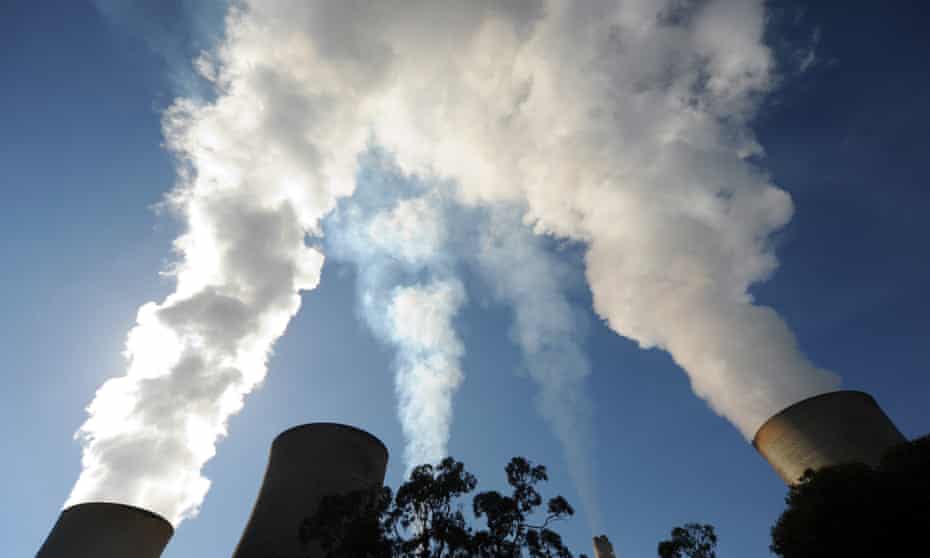Extract from The Guardian
If you examine the figures rather than the media release, it’s clear the Coalition has given up on the Paris agreement

Last modified on Tue 2 Nov 2021 11.40 AEDT
The Morrison government’s plan to reach net zero emissions by 2050 was quickly revealed to be based on laughable projections. But even worse, the latest projections for emissions to 2030, also released last week, reveal the government has totally given up on the Paris agreement and the task to keep warming below either 1.5C or 2C.
If you listened to the prime minister or read some compliant reporting over the past week you might think the latest greenhouse gas projections are a triumph.
But if you examine the figures rather than the media release, it’s clear that Australia’s task to do our share to limit warming to either 1.5C or 2C is harder now than it was projected to be last year.
First let’s look at the change in projections from 2020.
Last year, the industry department projected Australia would emit 479m tonnes of CO2 equivalent in 2030 – 22% below the 615m tonnes emitted in 2005. But the projections also included a “high technology sensitivity” scenario – a scenario in which technology improved faster than expected.
That projection had Australia emitting 436m tonnes of CO2 in 2030 – 29% below 2005 levels.
And would you believe it – technology has improved faster!
As Ketan Joshi first noted, the government has effectively taken the 2020 high technology scenario and made it the baseline in 2021.
That sleight of hand has the government now projecting 439m tonnes of emissions in 2030. Not only that, emissions in 2005 were revised up to 624m tonnes, giving us the 30% fall below 2005 levels by 2030:
The government insists the cuts come from measures announced in the 2021-22 budget such as “$464m clean hydrogen industrial hubs program”, “funding to support the development of carbon capture” and measures such as the “implementation of the safeguard crediting mechanism” and “support for voluntary climate action through an expanded climate active framework.”
If that all sounds like bunkum, it’s because it is.
The government’s own figures show that all of the difference in actual emissions from last year’s projections come from electricity – ie the shift away from coal:
If the graph does not display please click here
It means, as the Greens leader Adam Bandt has noted, while the figures anticipate “the closure of 11GW of coal capacity”, the government is simultaneously pursuing “electricity subsidies, carbon capture handouts and the Collinsville coal-fired power station feasibility study, all designed to keep coal in the system for longer”.
Even more absurdly, these new technology improvements that will supposedly lead to greater emissions cuts are only set to occur after 2024:
The government actually predicts more emissions until 2025 than it did a year ago.
The problem is that while the government keeps reducing its estimate for emissions in 2030, it also recalculates the actual emissions that have occurred since 1990 – and they keep rising.
If the graph does not display please click here
This matters because, as I have noted previously, we need to stay within our carbon budget.
The Climate Change Authority has estimated that to stay under 2C, Australia could only emit 10,100m tonnes of CO2 from 2013 to 2050. The Climate Targets Panel earlier this year re-calculated it to be 10,400m tonnes.
Last year’s projections suggested Australia had used up 4,239m tonnes of that total. But the latest figures suggest Australia had now used 4,287m tonnes.
That means our remaining budget from 2021 onwards has fallen from 6,161m to 6,113m tonnes.
To stay under 1.5C, Australia can only emit 7,760m tonnes of CO2, but the latest figures suggest we now have only 3,473m tonnes remaining.
To put it another way, we have used up 55% of our carbon budget for the 37 years from 2013 to 2050 in just eight years.
The purpose of the Paris agreement was to hold “the increase in the global average temperature to well below 2C above pre-industrial levels and pursuing efforts to limit the temperature increase to 1.5C above pre-industrial levels”.
The latest figures suggest we will exceed our 1.5C budget in 2027 and the 2C budget in 2034 even if after 2030 we go on a direct path to net zero by 2050:
To stay within our 1.5C budget we would need to start on a path to reach net zero by 2033 – this would require an 80% cut from 2005 levels by 2030.
If the graph does not display please click here
Even the task for staying within our 2C budget is tough.
On the current projections, after 2030 we would need to cut emissions by 63m tonnes a year – nine times more than the current projections of a 7m tonnes cut each year:
By contrast a 50% cut by 2030 would then give us until 2044 to get to net zero.
The latest greenhouse gas projections are a farce, based on technological pipe dreams not even reflected in the figures. But worse, they confirm that the government has effectively given up on Australia doing its share to keep temperatures from rising by more than either 1.5C or 2C.
The government’s own figures show that its net zero by 2050 target is nowhere near enough to limit global warming to safe levels.
No comments:
Post a Comment